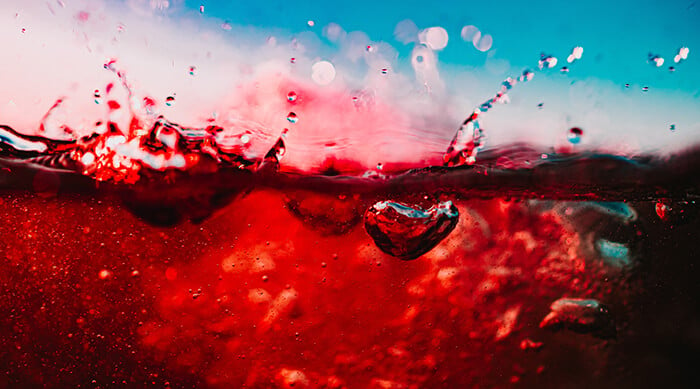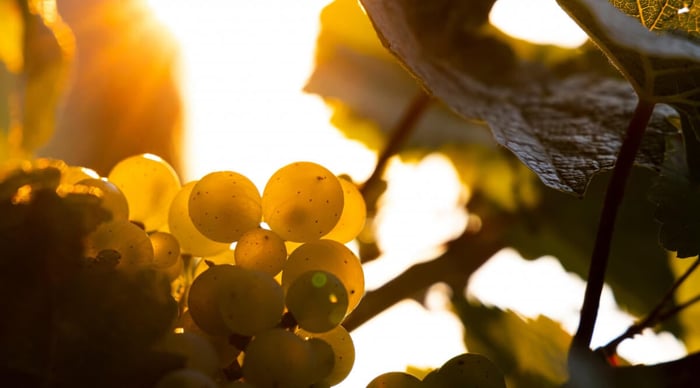Let’s get something out of way right off the bat: Wine is acidic.
Wine’s acidity is one of the fundamental traits you taste for when you’re at a wine tasting. It’s a measure of how crisp a wine is, even how much it makes your lips pucker.
From there, acidity in wine varies. Reds usually have lower acidity. The lighter the white wine, the higher the acidity level.
Most wine drinkers don’t have to worry too much about the acidity of wine. For those sensitive to acids, though, mindful drinking may not just mean keeping an eye on alcohol levels. You may want to swap in a low-acid wine, too.
Understanding the pH Scale
The pH scale is a way to measure the intensity of acidity in a liquid or an object. It isn’t just about things you consume, either. Soap (pH level 12), bleach (pH level 13), and basically everything with chemical makeup all has a place on the pH scale.
Water is a level 7 and considered neutral on the pH scale. A low pH or pH below 7 means something is acidic. Anything above 7 is considered alkaline.
We’ll get into specific wine grapes and varietals in a bit, but here are a few examples of where common beverages fall on the pH scale:
- Milk: 6.5-6.7
- Coffee: 4.7
- Tomato juice: 4.3
- Orange juice: 3.5
- Apple juice: 3.3
- Sports drinks: 3.3
- Grape juice: 3.0
- Cola: 2.5
- Lemonade: 2.0
Wine is comparable to citrus juices or juices high in citric acid when it comes to pH level, with an average pH of 3-4. It isn’t always about how sour something tastes, although sourness is a good indicator of acidity.
Some wines and beverages like sodas have a high acidity despite their sweetness. That likely means you’re dealing with high sugar content. If you’re watching both the acid and sugar in your drinks, be sure to read the labels.
Total acidity, or titratable acidity, is a different measure than pH. It tells you the total amount of acid in a bottle of wine. Wines with a high total acidity will typically have a low pH.
Read Next: 12 Non-Alcoholic Wine Substitutes for Cooking With Wine
Why is wine acidic?
Wine is naturally acidic, no matter the grape variety. Grapes have different types of acids like malic and tartaric acid, the two most prominent acids in wines.
From there, where the grapes grow affects acidity levels. Grapes grown in potassium-rich soil can bump up the pH of the harvested fruit. Some winemakers add tartaric acid to boost the acidity of these grapes to keep flavors in balance.
Grapes from cooler climates have a higher level of acidity. Warm climate grapes are usually lower acidity. Sunny skies and hot temperatures in warmer climates increase both the sugar content and pH levels of grapes on those vines.
Climates that get a little bit of both, like the hot days and cool nights of wine regions in Argentina, often result in red varietals like malbec. This red wine is full-bodied with low acidity.
Harvest times matter, too. Grapes allowed to ripen longer on the vine are higher in sugar but lower in acid. A winemaker can then pick grapes earlier or later in the season based on their desired end product.
Outside of wine’s natural ingredients, a winemaker can adjust the acidity in wine through a process called malolactic fermentation. Most red wines go through this process to tone down the tart malic acid in grapes in favor of milder lactic acid.
The process is also common in chardonnay, especially when winemakers want those buttery notes.
How Acids Affect Aging
Most wine experts agree that acidity is an important component in the drinkability of aged wines. As wine ages, its initial acidity decreases. Wines with a high acidity meant for aging may mellow out over time and improve. That means less of a sour taste when they’re finally popped.
You can assume the same for wines with a high astringency level. These are wines high in tannins, like resveratrol-rich red wines. When they’re not given enough time to age, it can result in a bitter mouthfeel on your palate.
Wines high in tannins and acidity will then age better. In the worst case scenario, wines without enough acidity can oxidize, or essentially go bad. Both tannins and acidity act like natural preservatives for wine.
Note: The vast majority of wines are meant for drinking within a year or 2 after you buy them at the wine shop. If you’d like to save a wine for a special occasion, though, go for higher acidity for better results.
How to Detect Acidity in Wine
Acidity in wine is something you look for when tasting wine for the first time. A high level of acidity doesn’t mean it’s a bad wine. A well-balanced wine is a combination of acid, sugar, tannin, and alcohol, the key components of wine.
A wine with a high pH and low acidity level can fall flat or lack structure. Wine enthusiasts call this a “flabby” wine. The lack of acid has stripped it of some of its depth. Bottling wines that are lower acid is a delicate balancing act.
Which wine is least acidic? Red wine varietals are generally less acidic than white wines. Cabernet, merlot, grenache, and malbec are all lower-acid red wines.
If you’re looking for a low-acid wine, there are a few additional things to look for: how a wine looks and how it tastes.
Look
You don’t even have to sip on a wine to start looking for clues that you’re dealing with a high-acid wine. If you’re drinking a red wine, the brighter or redder the pour, the higher the acidity.
Full-bodied reds like cabernet sauvignon or merlot can appear almost purple in the light, so hold your glass up for a better look if you’re targeting acidity in wine.
Most reds are still lower in acidity than most whites, with the exception of chardonnay. A buttery, straw-colored chardonnay will have a lower acidity than a crisp sauvignon blanc that is almost translucent in color.
Taste
What does acidity in wine taste like? Acidity in wine tastes like citrus. It’s sour and gives wines a tartness that can make your mouth water.
The more saliva your mouth produces while you’re drinking your wine, the higher the acidity.
High acidity can also taste crisp, fresh, or zesty. A high-acid wine doesn’t have to taste like biting into a green apple. In fact, that may mean something is out of balance. It’s more likely that you’ll get hints of citrus on the palate with a wine that’s higher in total acidity.
Wine and GERD
You’ve likely read all about the health benefits of wine, especially in red wine. The antioxidants in many red wines have been linked to improved heart health and longevity for some moderate wine drinkers.
For others, even functional wines are triggers for chronic conditions like gastroesophageal reflux disease (GERD) made worse by acids in your diet.
GERD is one of the most common digestive disorders out there. About 20% of Americans are diagnosed with it each year, and wine can worsen symptoms for some GERD sufferers.
The chronic digestive disease affects your stomach and esophagus. A common symptom is heartburn, a burning sensation in your chest caused by acid indigestion.
Symptoms usually get worse after eating or lying down. While diet and alcohol won’t cause the condition, they can be a trigger for GERD.
What are the best wines for people with acid reflux? The best wines for people with acid relux are wines with a lower level of acidity, like merlot, malbec, cabernet, and grenache.
The more important thing if you have acid reflux is to understand your food triggers and keep a food diary to note things that give you discomfort. Some people are able to drink moderate amounts of wine without a problem.
If wine is on your list of triggers, you may need to cut it out completely or try wine alternatives.
Acid Levels in Different Wines
Does white wine have the same acidity as red wine? White wine has higher acidity than red wine.
Generally, a full-bodied red wine like a French Bordeaux or zinfandel has a lower acid content than a light-bodied white wine. Medium-bodied wines or red blends fall somewhere in the middle.
Let’s take a look at how the wines rank when we look at pH alone:
Wine varietal pH
Champagne 3.06
Riesling 3.1
Sauvignon blanc 3.1
Prosecco 3.25
Viognier 3.3
Grenache 3.33
Pinot noir 3.34
Chardonnay 3.4
Sangiovese 3.4
Merlot 4.0
Food and Wine Pairings to Balance Acidity
Wines at a higher acidity level are like a palate cleanser. They’re bright, fresh, and can add balance to heavier foods. Here are a few tips to achieve balance in your food and wine pairings:
- Start with the food. Build your wine pairings around the food you’re serving. Consider how sweet, salty, sour, bitter, even fatty your menu is, and choose wines to balance out those characteristics.
- High acid works with high fat. Crisp white wines work well with cheese courses, creamy pastas, and heavier fare. Yes, you can pair high-acid wines with red meat. The acid cuts through the fat for a nice balance.
- Salt and acid work well, too. If you’ve never had champagne and French fries, you don’t know what you’re missing. A dry wine with a higher acidity brings out flavors in both what you’re eating and the wine you’re drinking.
- Avoid too much acid. If you’re serving a tomato-based dish, choose a lower-acid wine so you don’t overwhelm the palate with acid. Dry white wines work well with seafood and citrus, but if your white wine is too acidic, it can make both your wine and meal taste flat.
If you — and your body — don’t mind the acidity in wine, sip on whatever is pleasing to your palate. For an even healthier glass of wine, Surely non-alcoholic wine gives you all the good stuff about wine without the negative effects of alcohol.
Try our well-balanced pinot noir, sourced from high-quality California grapes. If you love the acidity in wine, taste our freshing non-alcoholic Sauvignon blanc.




